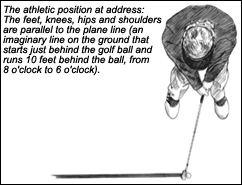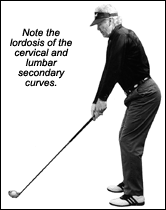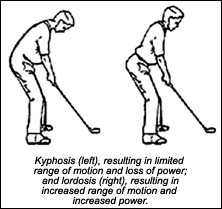For any athlete, the athletic position can be described as a state of readiness for motion and movement in any direction. There is positional alignment of the key load-bearing joints of the body (shoulders, hips, knees and ankles) in the frontal and saggital planes. The upright spinal column maintains positional lordosis of the secondary curves.
Sound golf posture is both static and dynamic. Static posture is responsible for your patient's overall alignment at the address position before the swing begins. The ability to maintain good posture during the golf swing is a measure of a golfer's dynamic postural strength and fitness.
The secondary spinal curves relate to your patient's ability to rotate for a powerful golf swing. We have been taught that the position of the structure dictates the function of the structure. Good golf posture requires that the secondary spinal curves be in lordosis. The secondary spinal curves provide mechanical leverage for strength and facilitate the patient's ability to rotate. Poor golf posture, with a collapse of the secondary curves, restricts spinal motion. This will cause the golfer to compensate by overswinging. Continuous overswinging leads to soft-tissue injuries.
Clinical Examination and Treatment Protocols
If a patient has unstable posture due to loss of secondary spinal curves, proceed with the following:
- extension traction of cervical and lumbar spine;
- upper thoracic extension stretching and exercise;
- soft-tissue release of the psoas and quadriceps; and
- restoration of hip function, with emphasis on the abductors and adductors.
Jeffry Blanchard, DC
Encinitas, California
www.DoctorForGolf.com
Dr. Jeff Blanchard is a practicing chiropractor who competes as a golf professional. He is the author of The PGA Professionals' Golf Injury Desk Reference (2007). For questions or comments regarding this article, contact Dr. Blanchard at 805-772-8298 or .







